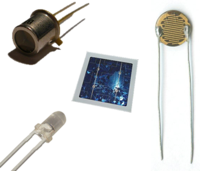
Photo from wikipedia
The development of sensitive, flexible, and transparent tactile sensors is of great interest for next-generation flexible displays and human–machine interfaces. Although a few materials and structural designs have been previously… Click to show full abstract
The development of sensitive, flexible, and transparent tactile sensors is of great interest for next-generation flexible displays and human–machine interfaces. Although a few materials and structural designs have been previously developed for high-performance tactile sensors, achieving flexibility, full transparency, and highly sensitive multipoint recognition without crosstalk remains a significant challenge for such systems. This work demonstrates a capacitive tactile sensor composed of two sets of facing graphene electrodes separated by spacers, which forms an air dielectric between them. The air gap facilitates more effective deformation of the top graphene electrode under pressure compared to typical elastomer dielectrics, resulting in a high sensitivity of 6.55% kPa−1 and a fast response time of ≈70 ms. Taking advantage of the remarkable properties of graphene for electrode usage, the tactile sensor presents sufficient transparency (over 70% at 550 nm) as well as excellent electrical and mechanical flexibility for 500 cycles at a bending radius of 8 mm. Simulated and experimental results validate that the isolation of each tactile cell by the spacers allows the pixelated sensor array to recognize the spatial distribution of applied pressure without crosstalk. The proposed sensor would be a promising candidate for tactile sensing components that require both flexibility and transparency.
Journal Title: Advanced electronic materials
Year Published: 2018
Link to full text (if available)
Share on Social Media: Sign Up to like & get
recommendations!